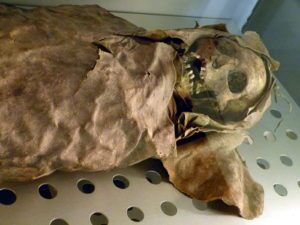
PLOS—People from North Africa are likely the main group that founded the indigenous population on the Canary Islands, arriving by 1000 CE, reports a new study by Rosa Fregel of Stanford University, USA and Universidad de La Laguna, Spain, and colleagues, published March 20, 2019 in the open-access journal PLOS ONE.
Numerous studies of the culture and genetics of indigenous people living in the Canary Islands, an archipelago off the coast of Morocco, point to North African Berbers as the founders, but more recent human activities – such as the Spanish conquest, the start of sugarcane plantations and the slave trade – have changed the indigenous population’s genetic makeup. To shed light on who first colonized the archipelago, researchers analyzed 48 ancient mitochondrial genomes from 25 archaeological sites across the seven main islands. They selected mitochondrial genomes because, since they are inherited directly from the mother, they are especially consistent and useful for tracking human migrations.
The researchers discovered lineages that have only been observed in Central North Africa, and others that have a wider distribution including both West and Central North Africa, and, in some cases, Europe and the Near East. They also identified four new lineages specific to the Canary Islands, which, when analyzed together, are consistent with radiocarbon dating evidence showing that people reached the islands by 1000 CE. Additionally, the researchers found that the distribution of the different lineages on each island varies depending on the island’s distance from the continent, which supports previous studies finding that the islands experienced at least two distinct early migration events.
The Canary Islands lineages discovered in this study fit into a larger pattern of Mediterranean migration through North Africa, as part of the Neolithic expansion of humans from the Middle East to Europe and Africa. The presence of these Mediterranean lineages suggests that the Berbers had already mixed with Mediterranean groups at the time that they colonized the islands.
The authors add: “Using next-generation techniques, we have been able to obtain ancient DNA of the indigenous population of all the seven Canary Islands for the first time. Our results indicate that mitochondrial DNA diversity is variable within the archipelago, suggesting that the colonization of the islands was a heterogeneous process and that the different islands had different evolutionary histories.”
____________________________

Guanche mummy of a woman (830 AD). Museo de la Naturaleza y el Hombre, Santa Cruz de Tenerife. Wofgang Sauber
____________________________
Article Source: PLOS news release
*Fregel R, Ordóñez AC, Santana-Cabrera J, Cabrera VM, Velasco-Vázquez J, Alberto V, et al. (2019) Mitogenomes illuminate the origin and migration patterns of the indigenous people of the Canary Islands. PLoS ONE 14(3): e0209125. https:/




